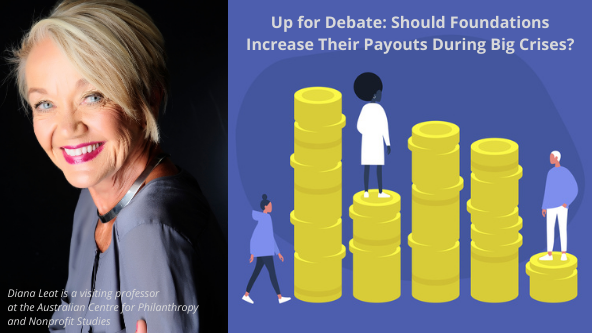
Adapting Oscar Wilde, it is tempting to define a philanthropoid as one who knows the size of the endowment and less about the real value of what it buys. For perhaps obvious reasons, dollars tend to be the dominant yardstick in the world of foundations. Philanthropic gifts are ranked by the number of zeros after the $ sign, foundations are ranked by the size of assets and annual spend. In a world of money, sums rather than value are king.
Larry Kramer makes a powerful case for stepping back from the immediate pressure to spend, and instead taking a longer-term view and adopting a more measured ‘it depends’ approach. He writes that “of course, a funder can almost always accomplish more good now by spending more money now,” but then argues that this is the wrong question. The right question, he says, is not whether a foundation can achieve more good now by spending more now but rather whether a funder can achieve more good overall by spending more now, taking into account the opportunity costs of not being able to spend as much in future. Thus “If I have a $10 billion endowment now, I can do more good than if I have an $8 billion endowment now,” and so, by implication, if I eat into my corpus now I can do less good in the future.

I do not want to imply that foundations care about endowment size as an end in itself, but I do want to question whether there is sometimes a tendency to equate the capacity to do good with the amount of money one has to spend. Is there really any evidence to suggest that there is a correlation between size of the endowment (or size of income or spend or individual grants) and the amount of ‘good’ achieved? Surely, the issue is not the numbers of dollars spent, but rather how they are spent. Is the most expensive Christmas present guaranteed to give the most pleasure, or do the most good? If only it were that simple!
Of course, that little word ‘how’ is a cover for a multitude of issues, value judgements, bets on the future, bets not just on what the grantee will do but what will be done by a multitude of others across sectors and over time. In other words, ‘the good grant’—the spend that does (most) good—is a mysterious phenomenon not given to easy capture in five-point formulae. Perhaps the best we can suggest is that a good grant likely to achieve the most good (skipping over the angels dancing on pins of definitions of ‘most good) is one that is appropriate, sufficient, timely and, probably, carefully targeted. I say ‘probably’ because while the best laid plans can go astray, and less well-laid plans can sometimes produce results out of all proportion to the apparent quality of the plan.
So the biggest endowment does not necessarily produce the most good. We can all think of very large grants that achieved very little and much smaller ones that punched way above their weight. You could, of course, argue that no grant is wasted if it leads to learning—but then we are into the realm of tautologies: all grants are good, even if they are bad.
Most foundations today recognize that they have assets other than money and that, relative to players such as government and the corporate sector, foundations’ financial expenditures are back pocket change. But foundations have assets that government, in particular, tends not to have. Foundations have independence, allowing them to take risks, to think the unthinkable and the unpopular, and to fail; foundations can afford to take a long view, not worrying about the electoral cycle; foundations have networks that span sectors and open many doors; and above all, at their best, foundations have continuity and knowledge built over decades, as well as a reputation as non-partisan seekers of the wider good motivated by more than electoral or party interest. It is not just, or even primarily, money but rather, or in addition, these assets that enable foundations to contribute to good.
Kramer acknowledges that there are some problems where it makes sense to keep spending now until the next marginal dollar yields no return, and that some problems require addressing today to head off future harm; that in itself is not an argument to spend but rather an argument to be open to spending if there is a real opportunity significantly to increase good. The root issue, as Kramer notes, is a choice between different views of what will help the most people in the most meaningful way over the long term. But surely, then, this is about judgements and opinions and not just about money.
Many years ago, Alan Gregg (a vice president at the Rockefeller Foundation between 1951-1956, and later described as ‘the model foundation officer’) gave a speech in which he stressed the value of adaptability in a rapidly changing society; even if you are not big, he told foundation leaders, you can be imaginative, sensitive, and agile ‘all qualities with a greater survival value than bigness alone.’ ‘We must seek quality not bigness.’ During a period such as this of huge change, surely the key concern should not be the preservation of ‘bigness,’ but the exercise of informed, imaginative, and sensitive judgement in pursuit of outcomes for the common good, whatever the cost. That is not an argument for spending (or not spending) but for critical thinking and analysis.
Support SSIR’s coverage of cross-sector solutions to global challenges.
Help us further the reach of innovative ideas. Donate today.
Read more stories by Diana Leat.

